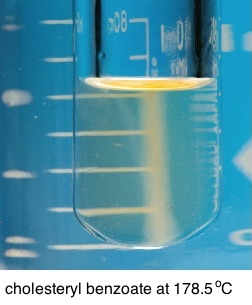Liquid crystals

 A.4 Liquid crystals (2 hours)
A.4 Liquid crystals (2 hours)
Pause for thought
The Nature of Science section for this sub-topic uses Reinitzer’s discovery of liquid crystals as an example of serendipity. In 1888 Reinitzer synthesised a new compound - cholesteryl benzoate.

cholesteryl benzoate (Image from Wikimedia commons)
In order to show that it was pure he needed to determine the melting point and was surprised to find that it appeared to have two different melting points. At 145.5 oC the white solid crystals melted into a cloudy liquid, which remained stable when heated further until178.5 oC. At this point the cloudiness disappeared to form a clear transparent liquid.


In fact it was one of his colleagues, Otto Lehmann, who realised that whilst the clear liquid had the isotopic properties and the disordered state of all liquids the cloudy liquid was a new state of matter intermediate between a solid and a liquid. He coined the label ‘liquid crystal’ to describe this new state of matter in which the properties depend upon direction even though the state is liquid.
As is sometimes the case with serendipitous discoveries it was initially seen as an interesting but not particularly useful fact and no real advances in the chemistry of liquid crystals was made until about 80 years later. The first commercial use of liquid crystal displays was not until the 1960s where they became incorporated into Swiss watches. Since then they have almost become ubiquitous and have made cathode rays tubes (which originally produced the pictures in televisions) virtually obsolete.
Nature of science
The discovery of liquid crystals is a good example of serendipity in science. They were discovered accidently by the Austrian botanist and chemist Friedrich Reinitzer (1857 - 1927) whilst experimenting on cholesteryl benzoate in 1888.
Learning outcomesAfter studying this topic students should be able to: Understand:
Apply their knowledge to:
| Clarification notesThe properties needed for liquid crystals include: chemically stability, a phase that is stable over a suitable temperature range, polar (so they can change Soapy water is an example of lyotropic liquid crystals. The biphenyl nitriles are examples of thermotropic liquid crystals. Limit liquid crystal behaviour to the biphenyl nitriles. Discussion of smectics and other liquid crystals is not required. International-mindednessThe production of many electronic goods is concentrated in areas of the world where poor working conditions may prevail. This raises the issue as to whether there should be internationally accepted labour standards for all workers, and, if so, what implications this would have on the price of consumer goods? |
Teaching tipsThis is a fairly descriptive topic, although it is possible for students to make a simple LCD (see other resources below). One way to start might be by getting students to list where they have seen LCDs in use so they realize their importance. Stress that the liquid crystal state is another state of matter and explain that it is in between the solid and liquid phase so that the molecules in the liquid still have some orientation rather than being randomly distributed. Make sure your students understand the difference between lyotropic and thermotropic liquid crystals with at least one example for each. Focus then on the biphenyl nitriles. Using their structures explain that: 1. They contain polar groups so that the intermolecular forces can align in a common direction. 2. The benzene rings ensure that the molecules are rigid and so more rod shaped and 3. The long chain alkyl group ensures that the molecules cannot pack too closely which helps to maintain the liquid crystal state. Finally explain how liquid crystal displays work stressing the idea of twisted nematic geometry and the interaction of liquid crystals with plane-polarized light. It is worth looking at the advantages and disadvantages of LCDs. It should then be fairly obvious that the properties needed by liquid crystals for use in an LCD are chemical stability, polar nature, stability in the liquid crystal phase over a reasonable temperature range and rapid switching speed (ability to orientate quickly). | Study GuidePages 114 & 115 QuestionsFor ten 'quiz' questions (for quick testing of knowledge and understanding with the answers explained) see MC test: Liquid crystals. For short-answer questions see Liquid crystals questions together with the worked answers on a separate page Liquid crystals answers. Vocabulary listserendipity |
Teaching slides
Teachers may wish to share these slides with students for learning or for reviewing key concepts.
Other resources
1. A good article from the official website of the Nobel Prize on ![]() The history and properties of liquid crystals. It also includes some embedded informative short videos.
The history and properties of liquid crystals. It also includes some embedded informative short videos.
2. A lecturer from the University of Hull explains liquid crystal displays using some wool, pasta, a bottle of water, a hair dryer and some stair gates. Who says you need expensively equipped labs to explain chemistry! This is real supermarket chemistry.
3. Fancy building your own liquid crystal display? This video by Ben Krasnow describes liquid crystals and what happens when you put them between polarizers. It includes a good description of how LCDs work.
![]() Building your own liquid crystal display
Building your own liquid crystal display

 IB Docs (2) Team
IB Docs (2) Team 















